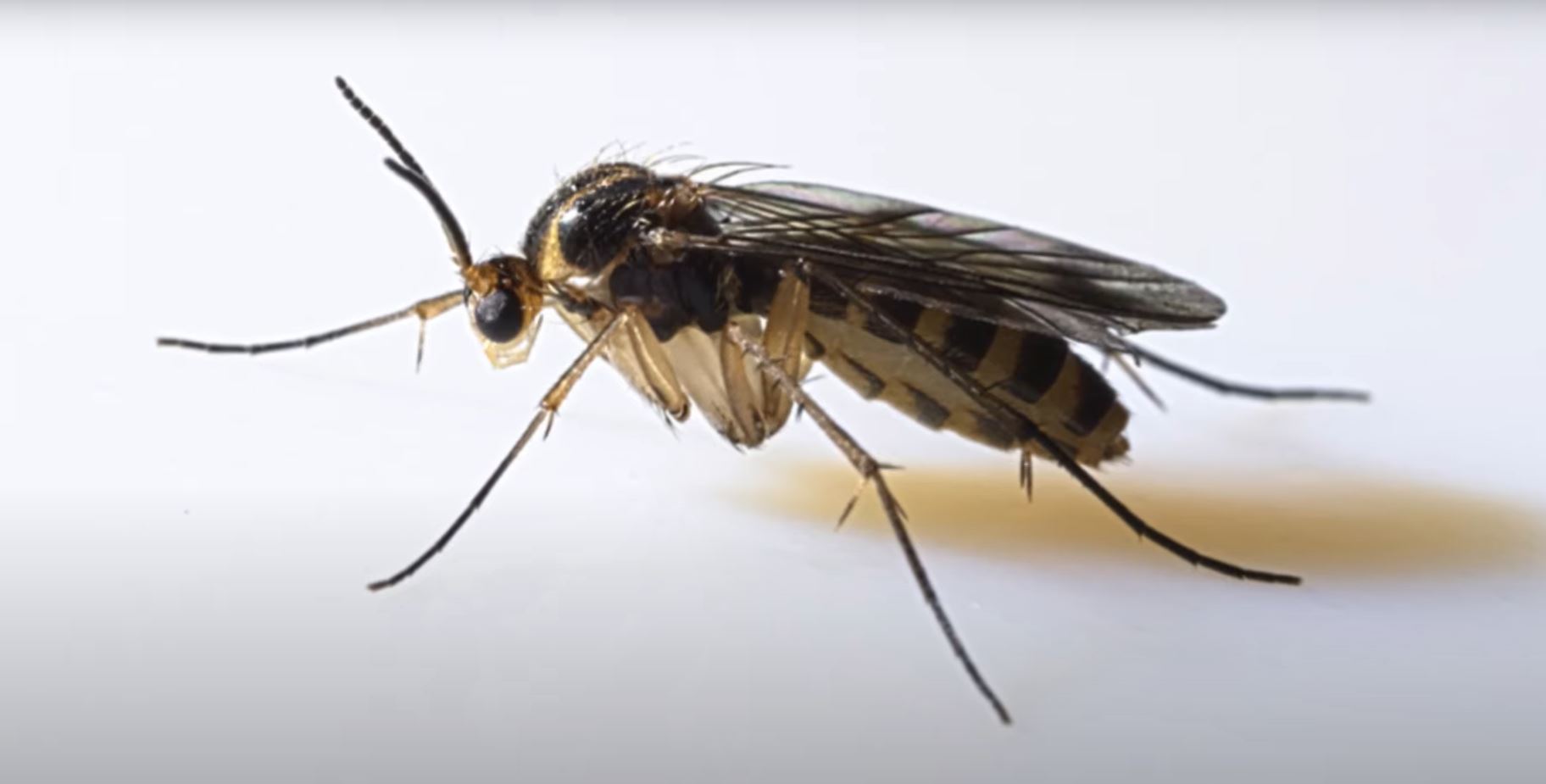Gnats are a nuisance. A simple household mishap like spilling juice on the counter and not wiping it away or forgetting to take out the trash for a couple of days can get your house covered in gnats.
You can find different types of gnats in your home such as drain flies, fruit flies, and fungus gnats. Getting rid of gnats is essential since these insects reproduce quickly and may cause significant damage to your potted plants.
The good news is that getting rid of these pests is not too difficult. It all starts with maintaining an environment that doesn’t attract them inside and around your home. Doing this allows you to enjoy summer without the annoying buzzing of gnats in your ear while ensuring you have a perfect garden at home.
Importance of Getting Rid of Gnats
Gnats can be a real nuisance, particularly when they’re biting. These bites can cause red bumps on the skin. Additionally, the bites are irritating and itchy. But it would help if you understood that not all gnats bite.

If you have plants in your home or garden, gnats can damage them by feeding on the roots and leaves. Not only does this damage your plants, but it also creates an ideal environment for mold growth.
Gnats can also contaminate food and spread disease. Additionally, fruit flies can lay about 500 eggs at a time. So, you can expect an infestation to grow rapidly and cause significant damage in a short period.
How to Get Rid of Gnats
If you discover a gnat infestation in your house, you should first try to identify the location of the grant infestation. You can do this by inspecting your home with a flashlight, looking for any droppings or webbing that may indicate their presence.
Once you’ve identified the source of the gnats, you’ll need to figure out how they’re getting into your home.
Common entry points include cracks and crevices, open doors, and windows. You may be able to block off these entry points yourself using some of the tips below.
To get rid of gnats, try using any one of the following methods:
Use an Apple Cider Vinegar Trap
Gnats and fruit flies can be a real pain when they invade your home. You can use an apple cider vinegar trap to get rid of them. This versatile ingredient has a sweet scent that gnats and fruit flies are drawn towards, but it also contains an extra-sticky soap that prevents them from flying away.
To make an apple cider vinegar trap, pour a few tablespoons of apple cider vinegar into a bowl or jar and stir in a few drops of sticky dish soap. Some people like to mix in a little sugar for extra sweetness, but this is not strictly necessary. Leave the trap out where you’ve seen fruit flies or gnats, and they’ll soon be attracted to the sweet-smelling vinegar.
If you’re dealing with a particularly stubborn infestation, you can try making multiple traps using small bowls or jars so that there are plenty of spots for the bugs to congregate. You may also want to move your traps around periodically since fruit flies tend to be more active near the walls of your home, where they’re likely to come in through open windows or doors.
Whether you’re dealing with gnats or fruit flies, using an apple cider vinegar trap is a simple and effective way to get rid of these annoying pests. It is also just one of the ways you can live green in the city while eliminating gnats at home.
Make a Wine Bottle Trap
Aside from the vinegar and dish soap trap, you can also use empty red wine bottles to make dish soap traps. Gnats are attracted to the sweet smell of wine and cannot leave through the small neck of the bottle once they’ve entered.
You can put a few drops or a few tablespoons of liquid dish soap into the bottle. There’s no need to do anything else to the trap, so place your wine bottle traps in areas where you notice gnats gathering.
You can also set up wine bottle traps around your home. To maximize their effectiveness, focus on places where you’ve seen large concentrations of gnats.
Flush Bleach into the Drain
If you notice an infestation of drain flies, you can try to flush the drain with bleach. Bleach is effective in killing these flies, and it will also sanitize your pipes in the process.
To flush bleach into a drain affected by drain flies, you should first protect yourself from exposure to the bleach. Protecting yourself involves properly covering your mouth and nose with a mask or bandana and properly covering any skin that may be exposed to the cleaning agent.
Once you have protected yourself, pour half a cup of bleach into a gallon of water. Take care to pour the mixture slowly and carefully down the affected drain. Allow it to soak for a few minutes before flushing it with warm water. Flushing with warm water should help to eliminate the larvae and eggs that may be present in your pipes. You can pour boiling water into the sink drains if you don’t have bleach. Boiling water should kill the eggs in your pipes and help prevent any future infestation of drain flies.
Use a Spray Bottle
If you’re dealing with a few gnats at home, you can use a spray bottle to eliminate them. Mix a cup of water, a tablespoon of vinegar, and a little dish soap in the spray bottle. Whenever you see gnats flying around the house, give them a light spritz with the solution to kill them on contact.
Put a shallow bowl, cup, or dish near your plant, and fill it with about a cup of white vinegar and a few drops of dish soap. The solution will lure the gnats in, and they’ll fall in and drown. Even though the solution can attract gnats, you can also lure them with ripe fruit.
Use Flypaper
Using flypaper is an effective and easy way to get rid of gnats at home. This simple method involves hanging sticky ribbons or window paper from areas where gnats are commonly found, such as windows and doorways. The adhesive coating on the flypaper attracts and traps flying pests, effectively removing them from your home. So if you’re looking for a reliable and satisfying way to eliminate these pesky insects, try flypaper today.
Hire a Professional
Hiring a professional pest control company is a good idea if your gnat problem persists or is particularly large-scale. These companies will have the tools and expertise necessary to determine the source of your infestation and use specialized methods to target larvae and adult gnats. In addition, they can customize a treatment plan specific to your home based on its size, layout, and condition. And they’ll help your gnat problem is severe. These companies treat infestations caused by various types of pests, including gnat larvae. They can assess your home’s situation and create a tailored treatment plan based on the type and extent of the infestation.
Types of Gnats
There are several types of gnats that you might find in your house, and each one will be attracted to different things. Here are the most common types of gnats that you may encounter:
Drain Flies
Drain flies are bugs that live in sewers, drains, and septic tanks. They have larger wings than most other gnats, and their bodies are furry, like those of moths. Drain flies—also known as moth flies—are small, dark-winged gnats with scales on their wings, making them look like a cloud of fine dust when killed or squashed. These nuisance bugs can be found resting on walls and ceilings and will fly short distances in response to being disturbed.
Fruit Flies
You can find fruit flies near garbage disposal systems, compost bins, or restaurants. These tiny insects can be easily identified by their small size and brown or black bodies. An overripe fruit or vegetable is their favorite food. So, these bugs usually turn up near a fruit bowl or trash can. Similarly, rotten vegetables also attract fruit flies. Even though you can see these insects during summer, fruit flies also come out during cold months.
Fungus Gnats
Fungus gnats are tiny bugs that look kind of like flies. They are black with silver tints and have long legs and antennas. Their appearance makes them look like they’re almost dancing when they fly.
These pesky pests tend to hang out near the soil of houseplants and are especially common in nurseries, where they can easily hitch a ride home in your potted plant. These gnats lay eggs in wet soil, and once the eggs hatch, you’ll start seeing tiny black larvae crawling around your houseplant.
Sand Gnats
Sand gnats are small, biting midges often found near water sources such as ponds, marshes, and swamps. You can also find these gnats along the edges of streams.
The female sand gnats lay eggs in moist mud around these areas, where the larvae develop. Sand gnats are tiny insects that can be quite annoying, as they bite and leave behind itchy red welts on the skin. These gnats can be difficult to avoid, as they are often found in areas with standing water or near bodies of water.
Reasons for Gnat Infestation
Before dealing with a gnat problem at home, you should know the reasons behind a gnat infestation at home.

One of the common ways gnats can get into your home is through cracks or tiny holes in its foundation or walls. They are also attracted to damp, smelly places like garbage cans, toilets, and the home’s kitchen sink.
They also turn up in your home’s drains. Other factors that lead to an infestation include:
- Rotting fruits and vegetables on your kitchen countertop.
- Open food containers.
- Overwatered indoor plants.
- The presence of mold or mildew.
One thing to remember when dealing with gnat infestations is to kill gnats quickly since they can reproduce fast. It would help if you dealt with these insects before gnat infestations start.
Gnat infestations can be a real annoyance, but thankfully there are plenty of ways to deal with them. You can start by trying simple DIY solutions like getting rid of standing water and using sticky traps. If these methods don’t work, it might be time to call in a professional pest control company. These companies specialize in treating gnat infestations and will be able to create a tailored treatment plan based on your home’s specific needs.




